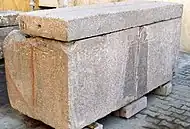Kawab
Kawab is the name of an ancient Egyptian prince of the 4th Dynasty. He was the eldest son of King Khufu and Queen Meritites I. Kawab served as vizier and was buried in the double mastaba G 7110–7120 in the east field which is part of the Giza Necropolis.
Kawab | |
|---|---|
 Kawab's sarcophagus | |
| Burial place | Mastaba G 7110–7120 at Giza |
| Occupation(s) | Vizier Priest |
| Title | Crown Prince of Egypt |
| Spouse | Hetepheres II |
| Children | Prince Duaenhor Prince Kaemsekhem Prince Mindjedef Queen Meresankh III |
| Parent(s) | King Khufu Queen Meritites I |
Biography
| Kawab K3 wˁb His Ka is pure in hieroglyphs | ||||
|---|---|---|---|---|
| Era: Old Kingdom (2686–2181 BC) | ||||
Kawab was the eldest son of Pharaoh Khufu and Meritites I and half-brother of pharaohs Djedefre and Khafre. He was possibly born during the reign of his grandfather Sneferu. Kawab married his sister Hetepheres II. They had at least three sons named Duaenhor, Kaemsekhem and Mindjedef and a daughter Meresankh III.[1]
Kawab died during the reign of his father[2] so the next ruler was Djedefre, who married his widow Hetepheres II. It used to be believed that Djedefre had Kawab murdered, since Djedefre was buried in Abu Rawash, instead of Giza, which was the custom. Djedefre's pyramid was also vandalized, but it is now thought that the tomb was vandalized much later, that is, during Roman times.[1]
Kawab's titles included officiant of Anubis, Priest of Serket, King's son of his body, King’s eldest son of his body, hereditary prince, chief of the ten(s) of Upper Egypt, sole companion of love, vizier (the title of vizier occurs on a statue from Mitrahina).[3]
Titles
The full list of titles of Kawab were:[4]
| Title | Translation | Jones Index |
|---|---|---|
| imy iz | he who is in the iz-bureau, councillor | 247 |
| iry-pˁt | hereditary prince/nobleman, 'keeper of the patricians' | 1157 |
| ˁȝ dwȝw | assistant of Duau | 1308 |
| wr di.w pr ḏḥwty | Greatest of the Five in the temple of Thoth | 1471 |
| ḥȝty-ˁ | count | 1858 |
| ḥm-nṯr srḳt | priest of Serket | 2120 |
| ḥts(?) Inpw ... | Reading unknown but related to Anubis (Inpw) | 2501 |
| ḫrp iȝwt nbwt nṯrwt | director of every divine office | 2541 |
| ẖry-ḥbt ḥry-tp | chief lector priest, lector priest in charge | 2860 |
| zȝ nswt | king's son | 2911 |
| zȝ nswt n ẖt.f | King's son of his body | 2912 |
| zȝ nswt smsw | king's eldest son | 2913 |
| zȝ nswt n ẖt.f smsw | king's eldest son of his body | 2914 |
| smr wˁty n(y) mrwt | sole companion, possessor of love | 3277 |
| tȝyty zȝb ṯȝty | he of the curtain, chief justice and vizier | 3706 |
| wr 10 šmˁ | Greatest/Great one of the ten of Upper Egypt | 1437 |
Translations and indexes from Dilwyn Jones.[5]
Tomb
Kawab was buried in a large double mastaba G 7110-7120 in the east field which is part of the Giza Necropolis. Mastaba G 7110 belonged to Kawab's wife. Her name was found in the chapel. G 7120 belonged to Kawab.[6] A relief in the door way shows Kawab standing before his mother:
zȝ.s mr.s kȝ-wˤb, zȝt nṯr.s ḫrp jmȝt sšmt mrt-jt.s mwt.f mst n ḫwfw
"Her son, her beloved, Ka-wab, the daughter of her god, she who is in charge of the affairs of the jmAt, Meritites, his mother, who bore (him) to Khufu."[3]
Four burial shafts were constructed as part of the mastaba. Shaft G 7110A was never used. Shaft G 7110B was originally intended for Hetepheres II, but was never finished and shows no sign of ever being used. This is most likely due to the fact that Hetepheres remarried after the death of her husband. Shaft G 7120A was the burial place of Kawab. A red granite sarcophagus was made for Kawab and found in place. The sarcophagus is inscribed with the following text:
1) "A boon which the king gives and Anubis, foremost of the divine booth, a burial in the necropolis as a possessor of a well provided state before the great god, officiant of Anubis, priest of Selket, Kawab
2) a boon which the king gives and Anubis, foremost of the divine booth, a burial in the necropolis in the western cemetery, having grown gracefully old, the king’s son of his body, Kawab
3) king’s eldest son of his body, officiant of Anubis, Kawab."[3]
After death
Several centuries after Kawab died, Prince Khaemweset, son of Ramesses II, restored Kawab's statue in the temple of Memphis.[7]
In popular culture
The film adaptation of David Macaulay's 1975 book Pyramid depicts Kawab as being killed by an ambush near the border between Egypt and Nubia.
Sources
- Dodson, Aidan and Hilton, Dyan. The Complete Royal Families of Ancient Egypt. Thames & Hudson. 2004. ISBN 0-500-05128-3
- Dodson & Hilton, p.59
- Simpson, William Kelly. The Mastabas of Kawab, Khafkhufu I and II. Giza Mastabas 3. Boston: Museum of Fine Arts, 1978. pg 1-8, Plate I-X, Retrieved from gizapyramids.org Archived 2008-10-11 at the Wayback Machine
- Baud, Michel, Famille royale et pouvoir sous l'Ancien Empire Egyptien 1 & 2 IFAO, 1999, [http://gizamedia.rc.fas.harvard.edu/images/MFA-images/Giza/GizaImage/full/library/baud_famille_1.pdf - PDF from Digital Giza (2 parts), ISBN 2-7247-0248-4.
- Jones, Dilwyn, An Index Of Ancient Egyptian Titles Epithets And Phrases Of The Old Kingdom 1 & 2 BAR, 2000, ISBN 1-84171-069-5.
- Porter, Bertha and Moss, Rosalind, Topographical Bibliography of Ancient Egyptian Hieroglyphic Texts, Statues, Reliefs and Paintings Volume III: Memphis, Part I Abu Rawash to Abusir. 2nd edition (revised and augmented by Dr Jaromir Malek, 1974. Retrieved from gizapyramids.org
- "Kawab". Archived from the original on 2010-06-13. Retrieved 2010-05-08.